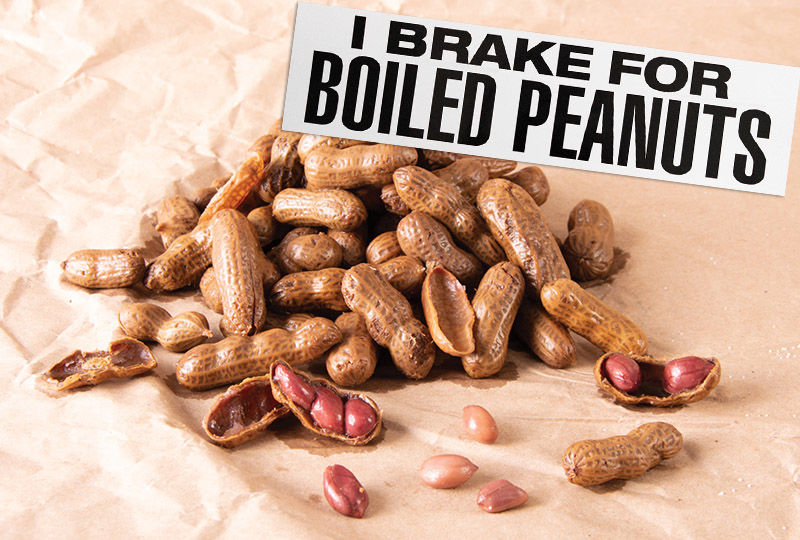A boiled peanut convert’s ode to Charleston’s culinary treasures

It was the heirloom tomato run that got me. On an oppressively hot July day in 2012, Charleston magazine sent me, then the assistant editor, on a hero’s journey across Wadmalaw and John’s islands to collect the best of the season’s ’maters. We were shooting a luscious tomato feature for the following year, and I was picked to grab the goods. Driving into the dusty parking lot of Sidi Limehouse’s Rosebank Farm Stand—at its original location just outside of Freshfields—it happened. The cashier looked at me with my box of plump, baby bottom-size Brandywines and asked, “Want some boiled peanuts to go with ’em?”
Even though I am “from off,” good manners taught me to accept the gift gratefully, and I’m thankful every day for that etiquette lesson, because as I bit down into those cold, smooth, and salty legumes while cruising up Maybank Highway, I swear a halo-wearing Mr. Peanut bestowed upon me a goober pea epiphany. Never again would I turn down boiled peanuts. And never again would I dismiss Lowcountry cuisine as just another bunch of regional dishes.
When I rolled into Charleston in 2002 for college, this naive girl from the Pacific Northwest was what you might call an “agriculture snob.” My roots are planted deep in the volcanic soil of Yakima, Washington, home to the nation’s best apples, pears, hops, mint, and on.... Let me put it this way, if farm communities were NBA teams, Yakima would be the 1990s Chicago Bulls, and I didn’t believe anywhere else in the world could compete.
Visits to local grocery stores only strengthened this conviction. The primary-colored produce sections of my youth—packed with 14 kinds of apples, Rainier cherries, apricots, honeydews, and blackberries, all picked minutes from my door—were gone. In their place I found, well, an awful lot of green. In hindsight, I realize this has to do with the fact that I, frankly, had no idea what I was looking at. Collard greens? Mustard greens? Turnip greens? What was this stuff?
...as I bit down into those cold, smooth, and salty legumes while cruising up Maybank Highway, I swear a halo-wearing Mr. Peanut bestowed upon me a goober pea epiphany.
The veggie plate at Hominy Grill (may it rest in peace) finally straightened me out. The lima beans, tomato pudding, mashed sweet potatoes, and cheese grits—heretofore unknown to me as a vegetable—were transcendent. And the hits kept coming.
I ate my first legit fried chicken at Martha Lou’s and realized a childhood of cold KFC was just a sad imitation of the real thing. I tried triggerfish for the first time at The Grocery in 2013 and was in awe. And then there were the all important classic food moments, like when I finally got to taste Huguenot Torte, a Charleston dessert tradition, at the Lee Bros. launch for GrowFood Carolina. Or my first luncheon at St. Philip’s Tea Room, where the warm Southern service and cool chicken salad sandwiches put me into a kind of dreamy afternoon trance. I fell in love with bivalves at a backyard oyster roast and became a soft-shell crab convert on a food crawl across the peninsula one spring.
But if this city’s restaurants were my entrée to Charleston’s food heritage, I didn’t come to fully appreciate any of it until I talked to the people creating the dishes. Tropes like “made with love” do little to describe the real deal passion this city’s farmers, chefs, and purveyors exhibited to me in my many interviews with them. Case in point: Gullah chef Charlotte Jenkins summed up the city’s greatest contribution in one sentence: “Gullah cooking is when you don’t have much to work with and you can make something great come from something little.”
Former GrowFood Carolina director Sara Clow put into words the dedication of Lowcountry farmers when we discussed the threat of Hurricane Irma to local crops: “That’s the thing about farmers, these are the most resilient people you’ll ever meet in your life.” And when I asked Carrie Morey of Callie’s Charleston Biscuits about how she came to rule her doughy empire, she said, “In my family, there is not a meal made without a story behind it.” These weren’t people in F&B to make a buck.; these were individuals who saw helping feed others as a higher calling. The more I got to know this community, the more flavorful everything tasted.
Maybe that’s why I get choked up thinking about my last Lowcountry supper. After 15 years reporting on this city’s culinary scene, I’m moving. The Old Dominion has called, and this summer my husband and I are heading north to be closer to family in Virginia. We’re excited to explore a new region—its history, culture, great outdoors—but I’d be lying if I said I wasn’t a bit nervous about the foodie wake-up call I’m in for.
What will a Saturday afternoon Camembert run be without the welcome greeting of Trudi and Patty at goat.sheep.cow.? Or a coffee stop without an early morning chat with Greer Gilchrist at The Harbinger Cafe? Will I ever find another Jackrabbit Filly where I can talk shop with the owner about writing while her husband makes incredible karaage? Do pros like Mickey Bakst, the definition of hospitality in human form, exist outside of Charleston? Where am I going to get my Not Fried Chicken ice cream drumstick fix in my new town of 612 people? I shudder to think of trying to track down fresh shrimp without Crosby’s just a short drive away. Or the ability to find pulled pork in a city that doesn’t have a Meathacking District.
I know there will be many new things to savor—meaderies, dozens of wineries, more country ham than you can shake a pig’s tail at—but there won’t be roadside boiled peanuts, and there won’t be all y’all who taught me to love them.